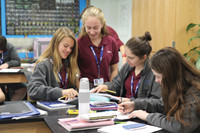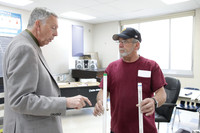

PROVIDENCE — As education advocates continue to debate the best practices for teaching students, school buildings are not left behind on the list of areas in need of improvement. Schools in both the public and private sector continually seek ways to update their facilities for best student outcomes, from tech centers to athletic structures to enhanced student security. For some schools, basic needs like a secure roof or heating system are first on the wish list of improvements.
According to Daniel Ferris, superintendent of schools for the Diocese of Providence, none of Rhode Island’s Catholic school buildings are in disrepair. However, in an age when the ideal learning environment requires much more than a working boiler and a roof that doesn’t leak, many schools are undergoing major physical improvements to continue to meet the changing educational standards of a 21st century school. Energy conservation measures, redesigned classroom spaces and safety and security concerns are the driving factors behind many schools’ current building projects, along with the importance of maintaining a visible Catholic identity while adapting to contemporary student needs.
“These are things that are going on nationally, and I’m very pleased that many of our schools are moving in that direction,” said Ferris.
To see how one of these priorities, energy conservation measures, impact a Catholic elementary school, Rhode Island Catholic visited Monsignor Clarke Catholic Regional School, Wakefield, where employees of Superior Electric Company recently replaced the school’s lighting with energy-efficient LED bulbs. According to an energy audit conducted by RISE Engineering, the new lighting will save the school approximately $8,000 per year in electricity costs.
“Our savings per month is actually greater than the cost it’s adding to our bill,” said John Zabriskie, the school’s operations manager. “They are so bright that we can run with half to 60 percent of the bulbs on.”
John Dickinson, one of the electricians who worked on the project, said that in addition to using less energy than traditional school lighting, LED lights are safer for a classroom setting due to their plastic design. They also last up to 15 times longer and do not require special disposal, as with mercury-containing fluorescent lights.
“Just the fact that you don’t have a maintenance man taking a bulb out and breaking a bulb and a child stepping on it [is significant],” he explained. “If it has to be disposed of carefully, it must be something you don’t want in schools.”
The school received grants from National Grid to complete the project, bringing the out-of-pocket cost down to about $14,000, according to Zabriskie. Support from utility companies, nonprofit organizations and other sources often provide the extra funds needed for a school, particularly a pre-K–8 school, to undertake a project. According to Ferris, cost is the main barrier faced by Catholic schools trying to make physical improvements.
“The other barrier is working with buildings that were designed 50, 75, 100 years ago when there was a different sense of a learning environment,” he said.
Many of the Catholic school buildings in use in Rhode Island today were built during the population explosion of the 1950s and 1960s. While most have undergone significant renovations, many still face particular challenges associated with older buildings, such as the replacement of original windows and upgrading of energy systems.
Redesigned classroom spaces have become a priority as educational standards shift to group-centered, technology-integrated learning that requires a different kind of environment than the textbook-and-chalkboard-based teaching methods of previous decades. Technology stations, grouped seating arrangements and the use of designated zones for different classroom activities have all become popular as classrooms adapt to the needs of contemporary students.
“What many of our schools have tried to do is take the 21st century skills and design classroom spaces in support of those skills,” Ferris explained.
At Monsignor Clarke, teachers and administrators have embraced the idea of designated zones for different classroom activities with the creation of a campus ministry room, a double-sized classroom featuring both traditional teaching space and a home-like, casually-furnished area for retreat activities or group work to one side. Though the room is still being furnished, teachers hope that, when completed, it will serve as the ideal space for religion classes, service club meetings and other activities not well-suited for a traditional classroom.
“This becomes another setting for kids to learn. It’s to provide a contrast,” explained Principal Dr. Arthur Lisi.
Though the resources and scale of renovation projects at Catholic schools around the diocese vary greatly, the educational principles behind them remain the same.
Recent updates at La Salle Academy, where an enrollment of 1,565 and support from an extensive alumni network allow the school to continually improve its facilities, reflect the same emphasis on group-centered, technology-integrated education driving projects at smaller schools like Monsignor Clarke.
Students in the academy’s De La Salle Middle School sit at triangular desks that can be rearranged for group work, while older students use “maker stations” to create projects in engineering or science.
A few years ago, a $400,000 Wi-Fi upgrade enabled the academy to implement a “Bring Your Own Device” policy that allows students to use their own laptops and tablets to log into a school network that handles up to 2,000 devices at one time.
“It’s interactive learning, it’s not the old days when everything’s silent,” said President Brother Thomas Gerrow.
Brother Gerrow also emphasized the importance of enhancing school security and maintaining a professional, modern appearance that fosters respect for the academic environment among students as well as visitors.
“I think too many people who don’t understand education don’t understand how important it is that places look clean,” he said. “It is that atmosphere that I know pays back great dividends in terms of the learning, the students’ experience.”
Ferris agreed that the physical atmosphere of schools is important for student education and added that students’ respect for their school buildings has in turn contributed to the continued wellbeing of these buildings over the decades. As in many other areas of Catholic education, the physical vitality of the schools relies on a partnership between students and educators.
“I think our students respect our schools. I think they care about our schools,” he said.